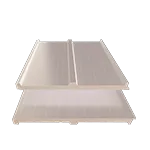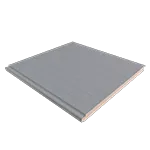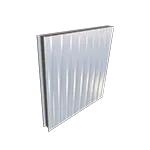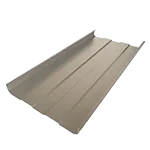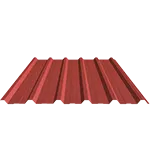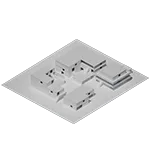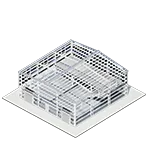Abstract
In the technical environments of building construction, it is increasingly common to hear questions about the R-value of the materials to be used in the building. In conversations between engineers and designers, the terms passive construction, thermal conductivity, and heat transfer are common when outlining the characteristics of a building. These expressions have their origin and importance in the R-value of materials.
Given this, it is necessary to know what it means and to understand what information the R-value gives us about each material used for the construction of buildings.
This conceptualization of R-values should be reflected in the thermal insulation of buildings and, in other words, in the improvement of the thermal comfort of the building, minimizing the intervention of mechanical equipment (heating or air conditioning) to achieve it.
R-value or Thermal resistance
Before getting into the subject, we should know a couple of important basic concepts: thermal insulation and thermal resistance.
Thermal insulation refers to the use or use of enclosures (floors, facades, or roofs) with materials that have a high thermal resistance to the transmission of heat flows.
By definition, thermal resistance (R) is the property of a product that can be composed of a material or several materials, having as a reference the unit of area in relation to its thickness, and indicates the efficiency of the product in terms of heat flow resistance. In simpler terms, it is an indicator of the product’s resistance to the passage of heat. Therefore, the higher the R-value, the greater the thermal insulation offered by the product.
This R-value is calculated by the thickness of the product divided by the thermal conductivity.
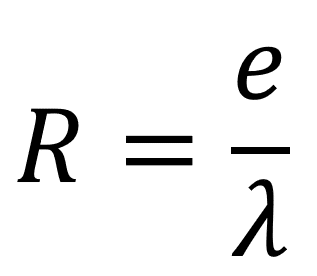
To better understand this formula, we must know what the thermal conductivity of a material is, which is designated by the Greek letter lambda.
Thermal conductivity is a physical property that all materials have and measures the ease with which the material transfers heat. It is measured by laboratory tests, and the lower the value, the better the insulating behavior of the material.
What we can see from this formula is that we can achieve better performance of the R-value (thermal resistance) if we increase the thickness of the product, or if we use products with much lower thermal conductivity.
| Conductivity, resistance, and transmittance values of materials | |||
| Conductivity | Resistance | Transmittance | |
| W/mk | m2-K/W | W/m2-K | |
| Non Insulated | |||
| Basalt | 3.500 | 0.029 | 35.00 |
| Sandstone | 3.000 | 0.033 | 30.00 |
| Reinforced concrete | 2.300 | 0.043 | 23.00 |
| Conventional concrete | 1.720 | 0.058 | 17.20 |
| Solid brick | 1.500 | 0.067 | 15.00 |
| Limestone | 1.400 | 0.071 | 14.00 |
| Adobe | 1.100 | 0.091 | 11.00 |
| Perforated brick | 0.740 | 0.135 | 7.40 |
| Thermo-clay blocks | 0.250 | 0.400 | 2.50 |
| Mid Insulation | |||
| Hardwood | 0.180 | 0.556 | 1.80 |
| Coniferous wood | 0.150 | 0.667 | 1.50 |
| Wood particle board | 0.130 | 0.769 | 1.30 |
| Cellular concrete | 0.090 | 1.111 | 0.90 |
| Expanded perlite panel | 0.062 | 1.613 | 0.62 |
| Insulated | |||
| Corcho expandido | 0.049 | 2.041 | 0.49 |
| Lana mineral | 0.040 | 2.500 | 0.40 |
| Poliestireno extruido | 0.038 | 2.632 | 0.38 |
| Poliestireno expandido | 0.037 | 2.703 | 0.37 |
| Poliuretano proyectado | 0.035 | 2.857 | 0.35 |
| Espuma de poliisocianurato | 0.025 | 4.000 | 0.25 |
The importance of thermal insulation in a building
It seems that lately, the concept of thermal insulation in buildings is in vogue. It appears in many building regulations and standards in various countries around the world. Much of its origins are based on improving energy efficiency inside the building.
In this way, we could say that it applies to countries with very cold climates, where heating costs through mechanical systems are very high. But we can also apply this efficiency in countries with warm climates, where the improvement of indoor comfort is subject to air conditioning equipment that, as we know, involves high energy consumption and money.
How do we achieve this thermal insulation in buildings?
When we refer to the thermal insulation of a building, we usually reduce it to the concept of preventing heat and cold from “entering” the building. But this is an erroneous simplification from a technical point of view.
Without going too deep and avoiding talking about physical laws, we will clarify the two situations that we can find concerning insulation:
- When the outside environment is warmer than the inside, we shall work to ensure that our thermal insulation prevents heat from entering the building.
- In the case of an outside environment that is colder than the inside, our thermal insulation must work to prevent heat from flowing out of the building.
And how do we achieve these thermal insulation conditions? By using the appropriate materials or construction systems that give us the highest possible R-value for each of the needs in the floor, facades, and roofs. This will allow us to reduce heat gains in warm temperature conditions and reduce heat losses in cold environments.
One thing that is important to clarify is that the calculation of these requirements will not be the same for cold and hot climates. What we mean by that is that in countries with predominantly cold climates, the thermal insulation requirements are more important than in areas with hot climates.
This is due to what we explained above, in a cold climate we are faced with the condition of avoiding the loss of the internal heat of the building. In the case of a building in a warm climate, although it is important to avoid the passage of heat to the interior, it is much more efficient if this is accompanied by good natural ventilation to “extract” the internal heat.
This does not mean that in hot climates it is less important to select materials considering their R-values, but rather that the resources used to improve thermal comfort will be different from a building in a cold climate.
A common example is the debate in some regions with warm climates as to whether it is better to close all windows and obstruct with thick curtains all external solar radiation or to open the windows completely and allow cross-wind circulation. Cross-circulation is nothing more than achieving openings (windows) in opposite spaces of a room, as we can see in the image.
The answer depends not only on the architectural characteristics of the building and the orientation but also on its use. A large space with one person is not the same as a small space with several people and several computers working simultaneously.
For all of the above, we can say that the proper design of thermal insulation inside buildings is a combination of active and passive elements, and within the correct choice of passive elements (floors, facades, and roofs) we have resources such as the R-values of the materials to make the calculations required to make decisions.
Materials with enhanced thermal performance
The manufacturing industry is in continuous search for materials with better performance and thermal resistance behavior. Achieving higher efficiency coefficients in less material thickness is one of the guidelines that are currently being worked on the most.
An example of this is Thermablock, a component developed at MIT and NASA with many applications in different sectors, initially in aerospace. Today this material has applications in the residential sector such as Thermablok Aerogel Insulation.
One of the most common ways of constructing industrial buildings is by using steel structural frames with sandwich-type insulating panels for roofs and walls. These panels are very easy to install, which represents an advantage for builders. They are also manufactured with materials of outstanding thermal performance (R-values), depending on their thickness, as well as the insulating material they are made of, which is usually polyurethane, polyisocyanurate, or rock wool. Although there are EPS and XPS, these can be highly flammable, so they are more and more out of use, even though their thermal resistance is at acceptable levels.
With such materials, builders and owners of commercial buildings and residential buildings benefit from high thermal resistance values, facilitating better control of temperature variations between the exterior and the interior, and obtaining significant savings in mechanical air conditioning equipment.
Given the above, we can say that the use of materials with a high R-value, as is the case of the insulated panels, allows for climate-efficient constructions, reduction of costs and assembly times in the construction process, as well as significant energy savings throughout the useful life of the building.
R-value: Conclusion
In conclusion, the R-value or thermal resistance of materials is an important factor to consider in building construction as it determines the efficiency of the product in terms of heat flow resistance. The R-value is calculated by the thickness of the product divided by the thermal conductivity, and the higher the R-value, the greater the thermal insulation offered by the product.
There are two ways to improve the R-values of thermal resistance in a building: using materials with a greater thickness or using materials that have a very low conductivity. In this way, better results are obtained.
Using materials or construction systems that provide a high R-value helps to achieve better thermal insulation conditions, which can help to improve energy efficiency, reduce heating and cooling costs, and enhance indoor comfort.
To establish the most efficient level of thermal insulation of a building it is necessary to know its conditions of use, location, architectural characteristics, and other particularities of the climate at the site.
